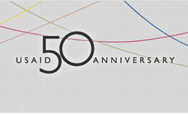Global Climate Change
INTEGRATING CLIMATE CHANGE INTO DEVELOPMENT
Climate change is one of the century’s greatest challenges, and will be a priority of our diplomacy and development work for years to come. Energy sector growth and resultant greenhouse gas emissions in developing countries over just the next thirty years are on track to equal the total emissions recorded to date. Climate change can compound pre-existing social stresses – including poverty, hunger, conflict, migration and the spread of disease – and threatens to diminish the habitability of our planet. Economies of many developing countries are heavily dependent on climate-sensitive industries such as agriculture, fisheries, forestry, and tourism, and poor communities are more limited in their abilities to adapt to climate change. Moreover, increasing energy supply and access are fundamental for development. The success of our development efforts will depend upon efforts to foster low-carbon and climate-resilient growth.
USAID sees climate change and development as inextricably linked. Climate change is not just an environmental problem, but a human problem with direct implications for hunger, poverty, conflict, water scarcity, infrastructure integrity, sanitation, disease, and survival. Climate change creates vulnerabilities for all countries and is likely to pose an additional challenge to sustainable development, especially in regions already at risk from food insecurity, ecosystem degradation, water scarcity, weak institutional capacity, and other social and economic stresses.
USAID recognizes that global warming poses an additional challenge to economic development and ecological balance worldwide, particularly for developing countries and countries with economies in transition. To respond to the threat that global climate change poses, USAID investments are working to spur reductions in global greenhouse gas emissions and to promote climate change adaptation in vulnerable countries and communities. As the lead entity in the U.S. Government for bilateral and regional assistance, USAID focuses on helping partner countries to establish the policy environments, improved governance, and financial incentives to set their economies on a low-emissions path of sustainable development and reduce vulnerability to climate impacts.
Addressing climate change means both helping countries mitigate (reduce) greenhouse gas emissions and adapt to (cope with) anticipated climate changes. This is essential because developing countries play an increasingly greater role in addressing climate change. The International Energy Agency estimates that more than 90% of carbon dioxide emissions growth from now until 2030 will come from the developing world. Additionally, global climate change presents serious, structural risks for developing countries, due to its broad impact on all sectors of an economy. In particular, the poorest countries with limited institutional capacity or resilience face the most difficult challenges.
Currently, USAID’s climate change funding is divided into three pillars that address these challenges:
- Adaptation: Helping communities and countries build resilience to climate change impacts
- Clean Energy: Supporting low emission economic growth
- Sustainable Landscapes: Conserving forests and reducing deforestation to reduce emissions
In order to strategically address the challenges and opportunities presented by climate change for USAID programming, USAID undertook an internal planning process and released a USAID Climate Change and Development Strategy (PDF 5MB) in January 2012. With the primary goal of sustainable economic growth, the five year strategy defines the priorities and plans by which USAID will help partner countries accelerate their transition to climate resilient, low emission development.
Related Links
Linked documents may require Adobe Acrobat Reader for viewing.
Back to Top ^
|




